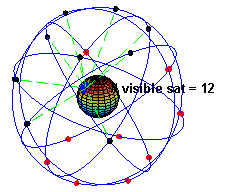File:ConstellationGPS.gif
ConstellationGPS.gif (240 × 192 pixel, dimensione del file: 485 KB, tipo MIME: image/gif, ciclico, 300 frame, 30 s)
Cronologia del file
Fare clic su un gruppo data/ora per vedere il file come si presentava nel momento indicato.
| Data/Ora | Miniatura | Dimensioni | Utente | Commento | |
|---|---|---|---|---|---|
| attuale | 16:56, 6 mar 2008 |  | 240 × 192 (485 KB) | Shushruth | {{Information |Description={{en|A simulation of the original design of the GPS space segment, with 24 GPS satellites (4 satellites in each of 6 orbits), showing the evolution of the number of visible satellites from a fixed point (45ºN) on earth (conside |
Pagine che usano questo file
Le seguenti 5 pagine usano questo file:
Utilizzo globale del file
Anche i seguenti wiki usano questo file:
- Usato nelle seguenti pagine di ar.wikipedia.org:
- Usato nelle seguenti pagine di ar.wikiversity.org:
- Usato nelle seguenti pagine di ast.wikipedia.org:
- Usato nelle seguenti pagine di as.wikipedia.org:
- Usato nelle seguenti pagine di ba.wikipedia.org:
- Usato nelle seguenti pagine di be-tarask.wikipedia.org:
- Usato nelle seguenti pagine di bg.wikipedia.org:
- Usato nelle seguenti pagine di bn.wikipedia.org:
- Usato nelle seguenti pagine di bs.wikipedia.org:
- Usato nelle seguenti pagine di ca.wikipedia.org:
- Usato nelle seguenti pagine di cs.wikipedia.org:
- Usato nelle seguenti pagine di da.wikipedia.org:
- Usato nelle seguenti pagine di de.wikipedia.org:
- Usato nelle seguenti pagine di de.wikinews.org:
- Usato nelle seguenti pagine di el.wikipedia.org:
- Usato nelle seguenti pagine di en.wikipedia.org:
- Surveillance
- Military satellite
- Nuclear weapons delivery
- User talk:El pak
- Time to first fix
- GPS signals
- Wikipedia:Featured picture candidates/February-2008
- Wikipedia:Featured picture candidates/Animated representation of the orbit of the GPS system
- Talk:Global Positioning System/Archive 6
- User:Boundarylayer/sandbox
Visualizza l'utilizzo globale di questo file.

